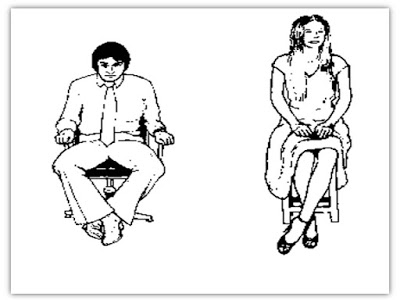坐姿腿和脚的手势揭示了什么?

Table of contents
腿部和脚部的手势可以提供最准确的心理状态线索。 身体部位离大脑越远,我们就越不清楚它在做什么,也就越无法控制它的无意识动作。
事实上,腿和脚的动作有时比面部表情更能准确地告诉你一个人在想什么。
这是因为我们更了解自己的面部表情,因此可以很容易地操纵它们,但没有人想过要操纵自己的腿脚动作。
脚踝锁
在坐姿下,人们有时会锁住脚踝,将脚收回到椅子下面。 有时,这种锁住脚踝的形式可能是将脚锁住椅子腿。
男性的膝盖通常是张开的,他们可能会紧握双手或紧紧抓住椅子的扶手,同时锁住脚踝。 女性的双腿也是后撤的,不过,她们的膝盖通常是并拢的,双脚向一侧分开。

在消极反应的背后,总会有一些负面情绪。
See_also: 感知和过滤现实的演变因此,做这个手势的人只是有一种负面情绪没有表达出来,他可能害怕、愤怒或对发生的事情不确定,但决定不表露出来。
退缩的脚表示做这个手势的人的退缩态度。 当我们比较 成 在交谈中,我们的双脚并没有退缩,而是 "参与 "到交谈中,它们向交谈者伸展,而不是躲在椅子下面沉闷的洞穴里。
这种手势在销售人员中很常见,因为他们不可避免地要训练自己对粗鲁顾客的消极反应。 我不知道你怎么想,但当我想象销售人员时,我想象的是一个穿着正装、打着领带的人,以直立的姿势坐在椅子上,在电话里说 "好的,先生!"时将脚踝锁在椅子下面。
虽然他的言谈举止显示出他对顾客的尊重和礼貌,但他紧锁的脚踝却透露出另一个故事,清楚地表明了他的真实态度,也许是......
"你以为你是谁,白痴,我也可以很粗鲁"。
出于显而易见的原因,在牙医诊所外等候的人和警方审讯嫌疑人时也会做出这种手势。
腿上的麻绳
缠腿是女性在感到害羞或胆怯时做出的动作。 一只脚的脚面在膝盖以下锁住另一只脚,就像鸵鸟把头埋在沙子里一样。 无论坐姿还是站姿都可以做出这个动作。 经常可以看到穿着暴露的女性做出这个动作,尤其是在电视或电影中的亲密镜头中。
当女人站在门口做出这个手势时,镜头故意对准了她的双腿,因为这个手势是能让男人疯狂的顺从手势之一。

有时,如果女性感到既自卫又胆怯,她可能会交叉双腿,同时做缠腿动作,如下图所示...

她的脸,因为她似乎在笑,说明了一个问题,而她的腿则说明了另一个问题(紧张)。 那么,我们该相信什么呢?
当然,答案是 "下半身",原因我刚才已经说过了。 那其实是假笑。 很可能,她装出假笑是为了在照片上看起来还行。 仔细观察脸部,看看隐藏在下面的恐惧,不,说真的......继续(识别假笑)
膝盖点
这种手势也是女性的特点。 坐着时,一条腿夹在另一条腿下面,夹着的那条腿的膝盖通常指向她觉得有趣的人。 这是一种非常随意和放松的姿势,只能在你觉得舒服的人面前做出。

抖动/拍打双脚
在关于焦虑行为的文章中,我提到任何抖动的行为都表示一个人想要逃离他所处的环境。 当我们在某种环境中感到不耐烦或焦虑时,我们就会抖动或拍打双脚。 这种手势有时也表示快乐和兴奋,所以请记住上下文。
See_also: 19 个原因短跑运动员的位置
在坐姿中,一只脚的脚趾紧贴地面,同时脚跟翘起,就像短跑运动员在比赛开始前 "各就各位 "时的动作一样。 这个手势表明,这个人要么已经做好了匆忙行动的准备,要么已经开始了匆忙行动。
当学生在考试时,时间所剩无几时,他们就会做出这种手势。 想象一位员工在办公室里以正常的速度工作,他的同事拿着一份文件闯进来说:"给,拿着这份文件,我们得马上处理,这很紧急!"
办公桌前的员工快速看了一眼文件,脚步就像短跑运动员一样,象征着他已经做好了 "快速竞赛 "的准备,随时准备紧急处理紧急任务。

